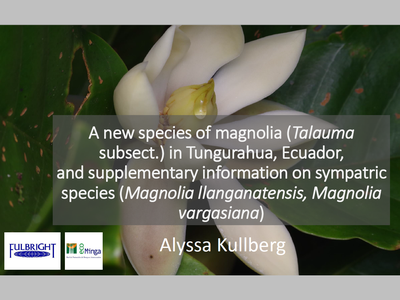Magnolia spp. in the Río Pastaza corridor, Tungurahua, Ecuador: Species distribution modelling of three Andean species and a description of Magnolia sp. nova (Talauma subsect., Magnoliaceae)
ALYSSA T. KULLBERG
EcoMinga Foundation, Tungurahua, Ecuador
The Ecuadorian cloud forests of the eastern Andes represent some of the world’s most biodiverse ecosystems and harbor high levels of endemism. However, they remain relatively unexplored by science and are at high risk of deforestation due to growing populations and land use change to pasture and agricultural land. Researching the biodiversity and potential ecological importance of species present in these vulnerable ecosystems is important to be able to prioritize areas for conservation. Three new magnolia species have been discovered in an area of under 20 km2 over the past five years: Magnolia llanganatensis, M. vargasiana, and one undescribed species that is referred to here as Magnolia sp. nova.
Magnolia sp. nova is similar to M. llanganatensis in range, pubescence, flower size, and petal number. However, Magnolia sp. nova has leaves with a broader, rounded base and longer petioles (2−5 cm). Leaves of Magnolia sp. nova are ovate to subcordate with an acute apex and an obtuse base. The abaxial side of the midvein is also pubescent. It is known to occur at higher elevation than M. llanganatensis, from 1625 m a.s.l. up to 2125 m a.s.l. Flowers between the two species are similar, although flowers of Magnolia sp. nova usually have less stamens than M. llanganatensis (37 SD = 2.3 versus 40 SD = 2, respectively). Magnolia sp. nova and M. vargasiana are largely co-occurring, but the latter has larger flowers, more stamens, rounder leaves, and glabrous to barely pubescent internodes and midveins.
Trees of Magnolia sp. nova are 10−20 m tall (diameter at breast height 12−32 cm). The bark is light yellow to pale brown. Twig internodes are pubescent and 0.2−0.5 cm in length. Petioles are 2.0−5.0 cm long, pubescent, with the stipular scar along its length. Leaf blades are 6.0−12.0 cm long with a pubescent midvein. One to two hypsophylls, green to medium brown and highly pubescent. The flower buds are ellipsoid with 3 sepals that turn from green/white to pink/tan when the bud is ready to open. Flowers have 6−8 fleshy, cream/white, spathulate petals, 3.0−4.4 cm long and 0.7−2.2 cm wide. Each bud contains 28−38 but up to 45 stamens, linear and cream to pale yellow. The gynoecium is ellipsoid with an acute apex, 2.8 cm long and 0.8 cm wide, 6−16 ovules. The fruit is green to reddish, asymmetrical, ovoid, and costate.
Magnolia sp. nova grows in dense (~800 trees/ha), wet, tropical cloud forest at 1625−2125 m. All ten known individuals are located on the eastern slopes of the Andes in the Cordillera Abitagua, south of Llanganates National Park, in the Río Pastaza watershed. This region receives up to 4000 mm of annual rainfall. Eight of the ten known individuals in primary forest, and two in secondary forest formerly cleared for small-scale pastureland.
Efforts at the Quito Botanical Garden to propagate the tree from cuttings have not been successful. All known individuals of Magnolia sp. nova are within the private protected areas of Reserva Río Zuñac and Reserva Machay, owned by the Fundación EcoMinga. There are 10 known individuals of Magnolia sp. nova, nine of which are located within a 3 km radius in the Reserva Río Zuñac.
For the purposes of species distribution modelling in MaxEnt (v. 3.4.1), clusters (within 0.5 km) of individuals within species were reduced to one to two individuals as a means of reducing cluster bias. Because exploring is often limited to more easily accessible areas on the steep slopes within the reserves, the number of individuals of each species used in the distribution models became limited to 13 individuals of M. llanganatensis, 19 of M. vargasiana, and 10 of Magnolia sp. nova. Nineteen bioclimatic factors (WorldClim) and elevation data were used to predict species distributions at a spatial resolution of 30 degree seconds.
The majority of suitable habitat predicted by the distribution models for all three species falls within the EcoMinga reserves, a result affected by their current known distribution. However, a significant portion of the predicted distribution of all three species lies to the north in the Llanganates National Park and to the south in Sangay National Park. This is a positive sign for the conservation of these species, as their predicted distributions are largely encompassed by areas already under protection for conservation. Notwithstanding, there are areas of high likelihood of presence of all three species that lie outside of any official protected areas, and this information may be used by the EcoMinga Foundation and other conservation organizations in the region to prioritize areas of high interest to incorporate into protected areas.
Based on the results of population sampling and distribution modelling, it is recommended that M. llanganatensis and Magnolia sp. nova be classified under the IUCN RedList parameters as endangered based on their limited known population sizes; restricted known habitats of the two species, which are under 8 km2 (with the exception of the one known individual of Magnolia sp. nova outside of the Río Zuñac Reserve); their relatively restricted predicted distributions; and their poorly understood reproduction, limited number of known juvenile individuals, and near failure to produce seeds among known individuals. There is not currently an IUCN RedList assessment for either of these two species.
M. vargasiana was assessed as endangered by IUCN shortly after the species was first discovered in 2016, and the assessment has not since been updated. At that time there were only two known individuals of the species, and now there are 211 known individuals, albeit also within a relatively restricted area. Considering the improved knowledge of the current population size and structure of this species as well as well-aligned phenology, it may be re-assessed as vulnerable.

